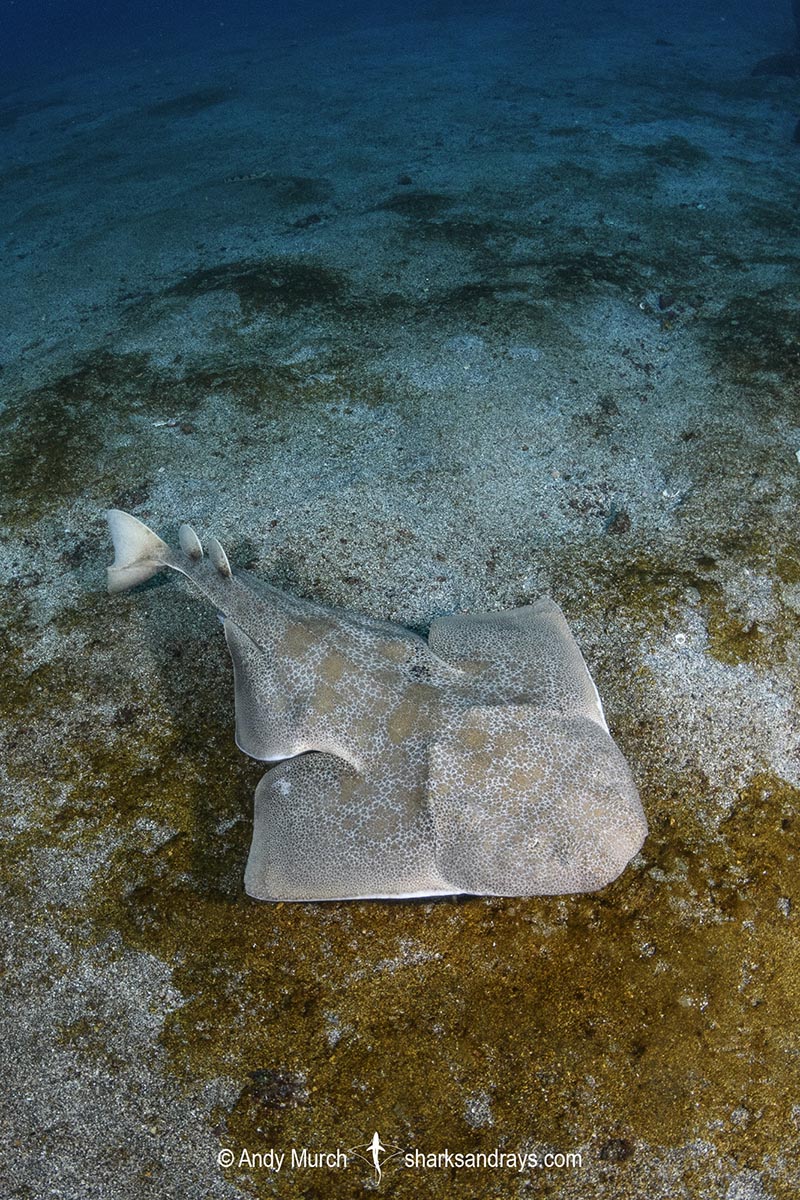Common names
Japanese Angelshark.
Binomial
Squatina japonica
Synonyms
None.
Identification
A large angelshark species with a head inline with the pectoral fin margins. Thin, unfringed, cylindrical barbells with slightly spatulate tips. Nasal flaps weakly fringed or smooth. Spiracle to eye distance about 1.5x eye size. Concave forehead between eyes. Rows of small thorns (enlarged denticles) present on snout, between eyes and spiracles, and along midline of back. Pectoral fins have somewhat rounded apexes.
Dorsal coloration cream or tan with a dense covering of irregular, reddish-brown spots. Spots on either side of midline coalesce to form large, paired irregular blotches. No ocelli on pectoral fins. Ventrum pale. Dorsal and caudal fins pale and unmarked except near their bases.
Size
Maximum size possibly to 2m, but mostly to 150cm. Size at birth approximately 30cm.

Conservation Status
CRITICALLY ENDANGERED
The Japanese Angelshark is susceptible to capture in ground fisheries including trawl, gillnet, set net, and longline. When caught as bycatch, it is generally retained for its meat and fins, and it is ground into fish meal.
In some parts of Japan it is still relatively common at shallow depths during the winter months e.g. in the southern reaches of Tokyo Bay, but it has not been seen for 20 years in other areas and where it has been reported over the past 40 years, catches are rare.
In Korea, the Japanese Angelshark has only been reported 3 times since 2014; probably due to intense fishing pressure for skates.
In Taiwan, it has not been seen for 20 years.
Overall, this species has undergone a population reduction of >80% over the past three generation lengths (69 years).

Habitat
Temperate sandy substrates often close to monumentation such as rocky reefs. Inshore and continental shelf. From around 15m (personal observation) to at least 300m.
Distribution
Northwest Pacific / Sea of Japan. Found from Korea, Japan, China, and Taiwan.
Reproduction
The Japanese angelshark is an aplacental viviparous species. 2-10 pups per litter.
Diet
Feed on demersal fishes, molluscs and crustaceans.
Angel sharks are ambush predators that lay on the substrate partially covered by sand. When a fish swims within range, the angelshark explodes upwards from its concealment, mouth agape and clamps down on its prey.
Behavior
Japanese angelsharks migrate into shallow bays along the Izu Peninsula during the winter months.
Reaction to divers
Easy to approach. Remains motionless, relying on camouflage. May occasionally bolt if molested.
Diving logistics
The Japanese angelshark is quite common at a few spots along the east coast of the Izu Peninsula and the west coast of the Bōsō Peninsula during the coldest winter months.
Tateyama on the Bōsō Peninsula is a great spot to look for angelsharks during the coldest months.
Another spot where Japanese Angelsharks are seen is Izu Ocean Park; a shore diving spot with a sandy slope that starts at around 15m and quickly drops to below recreational diving depths. However, IOP gets quite busy with local divers (especially at the weekend) causing the sharks to retreat into deeper water.
More difficult to reach (and therefore less busy) is Hatsushima Island off the east coast of Izu. This is an excellent shore diving site where numerous Japanese angelsharks can usually be found.
Mikomoto Island on the southeast tip of Izu is another area where angelsharks are regularly seen, but sightings are not as frequent as at Hatsushima and most of the sandy spots are at 30-40m.
The best way to search for angelsharks is to swim along the edge of the reef, about 2m above the sand, in rocky or kelpy areas where the sharks have sand they can hide under and access to a good supply of fishes.
Although the shark will likely be buried under a fine covering of sand, their outline is often somewhat visible. Even if the outline of the angelshark is obscured, they always keep their eyes and spiracles exposed. After a few encounters, you should be able to pick out the signs of a shark’s presence more easily.
Once you have located a shark, with slow, non-aggressive movements, it is usually possible to settle down next to it and gently fan away most of the sand to get a better look. This does not distress the animal or significantly waste its energy because one or two pectoral fin flaps will completely cover it again. Be careful not to wave your hand too close to its mouth to avoid a demonstration of its incredibly fast bite reflex!
What’s new
View our full list of updates
Similar species
Clouded Angelshark Distinguished by its bold pattern of large dark spots and scattered white spots, separated by irregular lines and smaller spots.














